
- The Mystical Allure of Ravens
- What Are Ravens and Crows?
- Can Ravens and Crows Be Your Pets?
- Is Owning a Raven or Crow Legal?
- Where Owning Ravens is Legal
- Legal Restrictions on Raven Ownership in Certain Countries
- How Long Do Ravens and Crows Live?
- Are Ravens Dangerous to People?
- Alternatives to Ravens and Crows as Pets
- Comparing Ravens to Dogs and Cats
The Mystical Allure of Ravens
The raven, a bird shrouded in mystery and steeped in tradition, has captivated human imagination for centuries. From the ancient tales of the Jewish, Christian, and Islamic traditions, where the raven was the first creature to embark on a post-diluvian world from Noah’s Ark, to the haunting verses of Edgar Allan Poe’s narrative poem, where it famously uttered “Nevermore,” the raven has always been more than just a bird. It’s a symbol, a character, and an enigma.
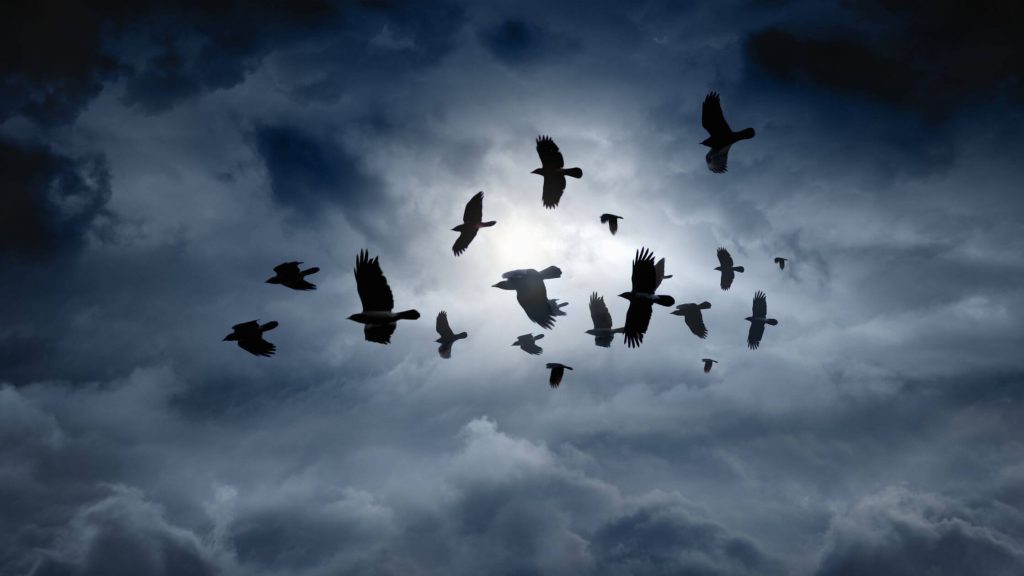
“Take thy beak from out my heart, and take thy form from off my door!” Quoth the Raven “Nevermore.”
Edgar Allan Poe
But let’s step away from the realm of myths and literature for a moment. In the real world, ravens are part of the fascinating Corvidae family, known for their exceptional intelligence and striking appearance. These birds are not just black; their plumage is a canvas of shimmering shades that play with light, creating iridescent patterns of blues, purples, and greens. It’s like nature’s own version of a hologram. And let’s not forget about their size – ravens are one of the largest passerines, or perching birds, you might come across.
But there’s more to ravens than meets the eye. These birds are known for their problem-solving skills and ability to mimic human speech – yes, you heard that right, they can talk back! In fact, their intelligence is often compared to that of dolphins and chimpanzees. A study conducted by researchers found that ravens can plan for the future, showing a level of cognitive sophistication previously thought to be exclusive to humans and great apes.
What Are Ravens and Crows?
Understanding Ravens and Crows
Ravens and crows, often subjects of fascination and mystery in various cultures, are more than just the carriers of mythic symbolism. As intelligent members of the corvid family, they stand out in the avian world for their remarkable cognitive abilities, often compared to those of great apes and dolphins.
Mystical Appearance of Raven Feathers
But it’s not just their brains that make ravens and crows so intriguing. Their physical characteristics are equally captivating. Ravens, for example, boast a glossy plumage that’s not merely black. Depending on the light, their feathers can shimmer with iridescent hues of blues, purples, and greens, giving them an almost mystical appearance. This sheen is the result of the structure of their feathers, which refracts and reflects light. The texture of their feathers is also notable, with a thick, shaggy appearance around their throats and necks.
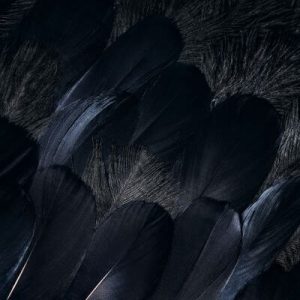
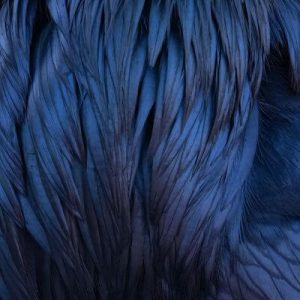
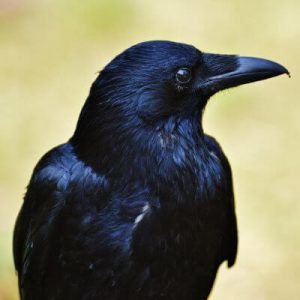

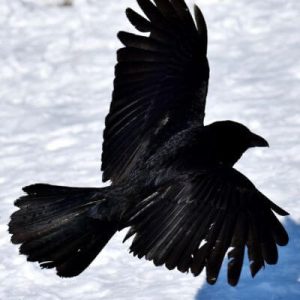

Distinct Differences: Ravens vs. Crows
Now, let’s talk about the differences and similarities between these two. While they may appear similar at first glance, there are distinct differences in size and plumage. Ravens are generally larger and heftier than crows, with a more robust bill and a shaggier appearance around their necks. Crows, on the other hand, are smaller with a smoother plumage. Their calls also set them apart – ravens have a deeper, more resonant croak, while crows have a higher-pitched, cawing sound. Despite these differences, both birds share the common trait of being highly adaptable, thriving in a variety of environments from rural countryside to urban landscapes.
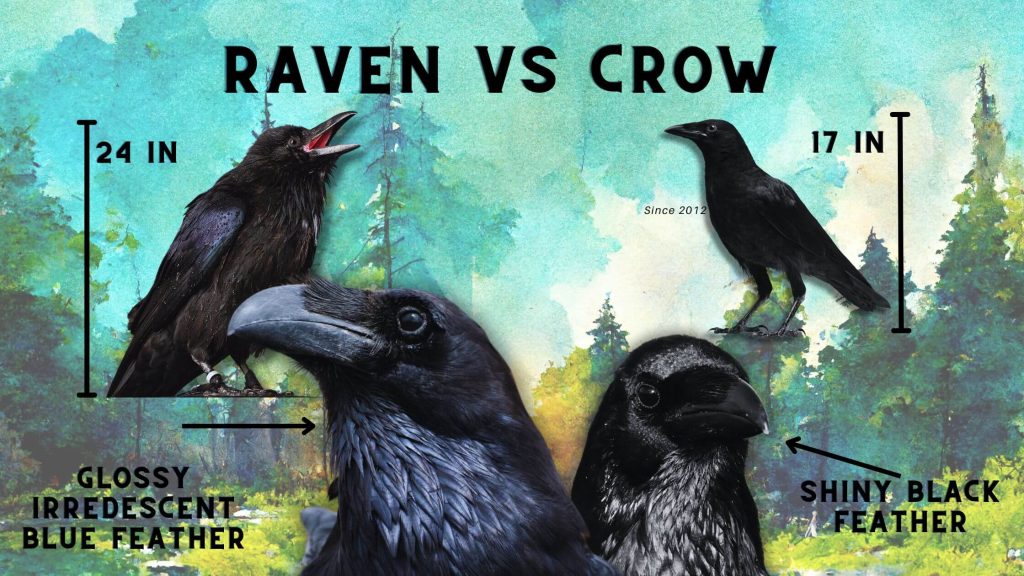
| Feature | Raven | Crow |
|---|---|---|
| Size | Larger, generally around 24 inches in length | Smaller, typically around 17 inches in length |
| Bill Shape | Thicker and more robust | Slimmer and straighter |
| Plumage | Glossy with iridescent sheen, often showing blues and purples; shaggier feathers around neck | Smoother and less shiny; uniformly black |
| Sound | Deep, resonant croak | Higher-pitched, cawing sound |
| Tail Shape | Wedge-shaped, longer | Fan-shaped, shorter |
| Flight Pattern | Soars more with wings forming a distinct ‘V’ shape | Flaps more frequently and steadily |
| Social Behavior | Often solitary or in pairs | More likely to be seen in larger groups |
| Intelligence | Exhibits complex problem-solving skills and planning for the future | Known for their adaptability and cleverness, but less studied for complex cognition |
Can Ravens and Crows Be Your Pets?
Ravens Need Space
Ravens and crows in the wild have vast territories, often spanning several miles. For instance, a study in the Pacific Northwest found that some raven pairs occupy territories of up to 20 square miles. In a domestic setting, mimicking this environment is challenging. These birds need space not just to move but to fly, exercise, and explore. Without ample space, they can become stressed or develop health issues. For a raven or crow to thrive in captivity, a large, secure outdoor aviary that mimics their natural habitat, possibly with trees and varied perches, is essential.
Crows and Ravens Are Social Birds
Ravens and crows engage in complex social activities in the wild, including cooperative hunting and play. They’re seen using sticks as tools and playing games like tug-of-war. In captivity, owners can engage them with puzzle toys, mimicry games, and foraging activities to stimulate their intellect. Creating a treasure hunt with hidden treats or teaching them simple tasks can be effective. Regular interaction is not just recommended, it’s vital for their mental well-being.
The Real Strength of Their Beaks
The beak of a raven or crow is not just for show; it’s a powerful tool. Ravens, for example, can exert pressure of approximately 1,400 pounds per square inch (psi), enabling them to break hard-shelled nuts or even dismantle objects. They have been known to break through materials like wood or even damage glass with their beaks. This strength means owners need to be cautious and provide suitable chewable and manipulable items to prevent unwanted damage.
Vocal Range and Noise Levels
Ravens and crows are among the most vocal of birds. Their calls range from deep, resonating croaks to high-pitched caws. Ravens can mimic human speech and other sounds, a talent that requires consideration in a domestic setting. Their vocalizations can reach up to 70 decibels – as loud as a vacuum cleaner. This aspect is crucial for potential owners to consider, especially in urban or densely populated areas, as it can lead to noise complaints from neighbors.
Wild Instincts
Keeping ravens and crows as pets raises significant ethical questions. These birds have evolved to live in the wild, with behaviors and instincts honed for survival in natural habitats. Captivity can suppress these instincts and alter their behavior significantly. For instance, ravens engage in aerial acrobatics and complex foraging behavior in the wild, activities that are hard to replicate in a home environment. This can lead to a range of issues, from depression to aggressive behavior. Prospective owners need to weigh the responsibility and ethical implications of keeping a wild bird in a domestic setting.
Is Owning a Raven or Crow Legal?
Navigating the Legal Landscape
Owning a raven comes with a complex set of legal considerations that vary significantly depending on your location. In many places, ravens are protected under wildlife conservation laws. For example, in the United States, ravens are protected under the Migratory Bird Treaty Act. This means that without a special permit, it’s illegal to keep a raven as a pet. These permits are rarely granted to individuals and are typically reserved for educational or rehabilitation organizations.
Why Legal Restrictions Exist
The legal restrictions around owning ravens are in place for several reasons. First, they are meant to protect wild populations from poaching and unsustainable pet trade. Secondly, these laws recognize the special needs of these birds, which can be challenging to meet in a typical household. Additionally, releasing captive ravens back into the wild can be problematic as they might not have the necessary skills to survive or could disrupt local ecosystems.
Research Local Laws
It’s imperative for anyone considering a raven as a pet to thoroughly research and understand the local wildlife laws and regulations. These laws can vary not just from country to country but also between regions or states within a country. For instance, some states in the U.S. may have specific regulations or bans on owning native wild birds. Violating these laws can result in hefty fines, legal action, and the removal of the bird from your care.
Seek Advice from Experts
Prospective raven owners should also consider consulting with wildlife experts or local authorities to understand the legalities and responsibilities involved. This could include reaching out to wildlife rehabilitation centers, avian specialists, or local conservation officers who can provide guidance and information about the legal requirements and ethical considerations of keeping a raven.
Where Owning Ravens is Legal
Countries with Lenient Raven Ownership Laws
The legality of owning ravens varies globally, with some countries having more lenient laws. However, it’s crucial to note that even in countries with more relaxed rules, specific regulations and conditions still apply.
- United Kingdom: In the UK, it’s legal to own ravens, but owners must ensure that the birds were bred in captivity and have proper documentation. The Wildlife and Countryside Act of 1981 requires that captive birds be ringed, indicating their captive-bred status.
- Germany: Germany allows the ownership of ravens with the stipulation that they are bred in captivity and the owner can provide adequate conditions for their wellbeing. Owners must also register their pets with local authorities.
- Russia: Russia permits the ownership of ravens, but the laws are subject to regional variances. Prospective owners should check local regulations and ensure they can provide an environment that meets the birds’ natural habitat needs.
- Canada: In some provinces of Canada, owning a raven is legal, but it often requires a special permit. These permits are usually granted for educational or conservation purposes rather than as pets.
Considerations and Conditions
Even in countries where it’s legal to own ravens, potential owners must meet certain conditions:
- Habitat Requirements: Providing an environment that closely resembles their natural habitat is essential.
- Healthcare and Welfare: Owners should have access to avian veterinarians and understand the specific dietary and healthcare needs of ravens.
- Breeding Restrictions: Many countries require that pet ravens be bred in captivity to protect wild populations.
- Permits and Documentation: In most cases, owning a raven requires permits or documentation proving the bird’s captive-bred status and the owner’s ability to provide proper care.
Legal Restrictions on Raven Ownership in Certain Countries
While some countries have lenient laws regarding raven ownership, there are others where keeping ravens as pets is strictly prohibited or highly regulated. These restrictions are often in place to protect wild populations and ensure the welfare of these naturally wild animals.
Countries with Strict Regulations or Bans
- United States: In the U.S., ravens are protected under the Migratory Bird Treaty Act. This law makes it illegal to own, transport, or sell ravens without a special permit, which is rarely granted to private individuals. The permits issued are usually for educational or rehabilitation purposes.
- Australia: Australia has strict wildlife laws, and owning native birds like ravens is generally prohibited. These laws aim to protect native species and their habitats. Special licenses are required for wildlife carers and educational institutions.
- Japan: Japan’s wildlife protection laws make it illegal to own ravens as pets. The country has strict regulations to conserve its native species and their natural habitats.
- India: In India, ravens are protected under the Wildlife Protection Act. It is illegal to own or trade ravens without a license, and such licenses are rarely issued for pet ownership.
Reasons Behind the Bans and Regulations
- Conservation Efforts: Many of these laws are in place to protect the natural wildlife and prevent the illegal trade of native species.
- Ecological Balance: Ravens play a crucial role in their ecosystems, and removing them from the wild can disrupt ecological balance.
- Animal Welfare: These regulations also consider the complex needs of ravens, which are difficult to meet in a typical household environment.
| Country | Legal Status of Raven Ownership | Notable Information |
|---|---|---|
| United Kingdom | Legal | Captive-bred ravens must be ringed; subject to the Wildlife and Countryside Act. |
| Germany | Legal | Ownership requires registration and proof of adequate living conditions. |
| Russia | Legal (varies regionally) | Local regulations differ; check regional laws for specifics. |
| Canada | Legal (with permit) | Permits usually granted for conservation or educational purposes. |
| United States | Illegal (without permit) | Protected under the Migratory Bird Treaty Act; permits rare and specific. |
| Australia | Illegal | Strict wildlife laws to protect native species; licenses rarely granted for pets. |
| Japan | Illegal | Strong wildlife protection laws focusing on conservation of native species. |
| India | Illegal | Protected under the Wildlife Protection Act; licenses for pet ownership rare. |
How Long Do Ravens and Crows Live?
Lifespan in the Wild vs. Captivity
Ravens can have significantly different lifespans depending on whether they are in the wild or in captivity. In the wild, a raven’s average lifespan is about 10 to 15 years. However, they face numerous challenges, including predators, disease, and competition for food. In contrast, ravens in captivity, provided with regular veterinary care, a balanced diet, and a safe environment, can live much longer. Some captive ravens have been known to reach ages of over 40 years. This extended lifespan in captivity highlights the importance of proper care and a stress-free environment.
In the wild raven’s live on average about 10-15 years but some captive ravens have lived up to 40 years
Factors Influencing Raven Lifespan
Several factors can influence the lifespan of a raven, both in the wild and in captivity:
- Diet: A nutritionally balanced diet is crucial. In captivity, this means a varied diet that mimics their natural food sources, including fruits, nuts, seeds, and occasional meat.
- Environmental Stress: High-stress environments can reduce lifespan. In the wild, this includes threats from predators and food scarcity, while in captivity, it can be a lack of space or environmental enrichment.
- Disease Prevention: Regular health check-ups and vaccinations, where applicable, can significantly increase a raven’s lifespan in captivity by preventing common avian diseases.
- Mental Stimulation: Both in the wild and in captivity, ravens need mental stimulation to stay healthy. This can include problem-solving activities and social interaction.
Are Ravens Dangerous to People?
Nature of Ravens’ Bond with Humans
Ravens are known for their remarkable intelligence, which allows them to form complex social relationships, including with humans. They are capable of recognizing individual human faces and can remember kind or unkind behaviors from people. While they don’t bond with humans in the same way domesticated pets like dogs or cats might, they can develop a sense of trust and familiarity with their human caregivers.
Ravens Compared with Traditional Pets
Unlike dogs and cats, ravens don’t show affection through wagging tails or purring. Their way of showing attachment might include mimicry, bringing gifts (like shiny objects), or seeking out interaction. However, their independent nature means they might not always seek out human companionship. It’s also important to note that ravens are not domesticated animals. Their bond with humans is based more on mutual respect and understanding than on the affectionate dependency seen in more traditional pets.
Alternatives to Ravens and Crows as Pets
Parrots: Intelligent and Social Birds
Parrots are a popular alternative for those interested in intelligent birds. Known for their vibrant colors and ability to mimic human speech, parrots like African Greys or Amazons can provide similar intellectual stimulation to ravens. However, they require significant social interaction, mental engagement, and a varied diet of fruits, vegetables, and specialized pellets. Their lifespan can range from 20 to 60 years, depending on the species, necessitating a long-term commitment.
Pigeons and Doves: Gentle and Low-Maintenance
Pigeons and doves offer a more serene bird-keeping experience. They are known for their gentle nature and can be quite affectionate with their owners. These birds need a diet of seeds and grains, along with a safe, comfortable enclosure. Unlike ravens and parrots, pigeons and doves are less demanding in terms of mental stimulation but enjoy social interaction.
Canaries and Finches: Small and Charming Songbirds
For those who prefer smaller birds, canaries and finches are charming alternatives. They are known for their beautiful songs and vibrant colors. These birds require a well-maintained cage, a diet of birdseed mix, and they enjoy flying space. While they don’t require as much social interaction as parrots, they thrive in pairs or small groups.
Comparing Ravens to Dogs and Cats
Care and Temperament
Ravens are vastly different from traditional pets like dogs and cats in terms of care and temperament. Unlike dogs, which are pack animals and thrive on social hierarchy and companionship, ravens are more independent and less likely to seek constant affection or approval. Cats, known for their independence, still differ from ravens as they have been domesticated over thousands of years, making them more adaptable to living closely with humans.
Unique Needs of a Unique Bird
Ravens require a specialized environment that mirrors their natural habitat, which is challenging to recreate in a typical home. They also need mental stimulation on a level that surpasses what is usually required for dogs and cats. In contrast, dogs and cats have been bred to live and thrive in domestic environments, with needs that are generally easier to meet by pet owners.
The Rewards of Ownership
While owning a raven presents unique challenges, it also offers unique rewards. Ravens can form strong bonds with their owners, display fascinating behaviors, and require engagement that can be intellectually rewarding. However, these rewards come with the responsibility of understanding and meeting their complex physical and psychological needs.
Beginner Guide to Raising Quail at Home
What are the Signs of a Dog Concussion?
What Causes Your Dog’s Ears to Smell Bad?
When your dog’s ears start to emit an unpleasant odor, it might leave you puzzled…
Methimazole Treatment for Cat Hyperthyroidism
Methimazole plays a crucial role in managing feline hyperthyroidism, a condition marked by an overactive…
Got Hummingbirds in your Backyard? Here’s How to Care for Them.
Why Does Your Cat Pee Outside the Litter Box?
Cat’s Litter Box Issues It’s not uncommon for cat owners to face the frustrating dilemma…




